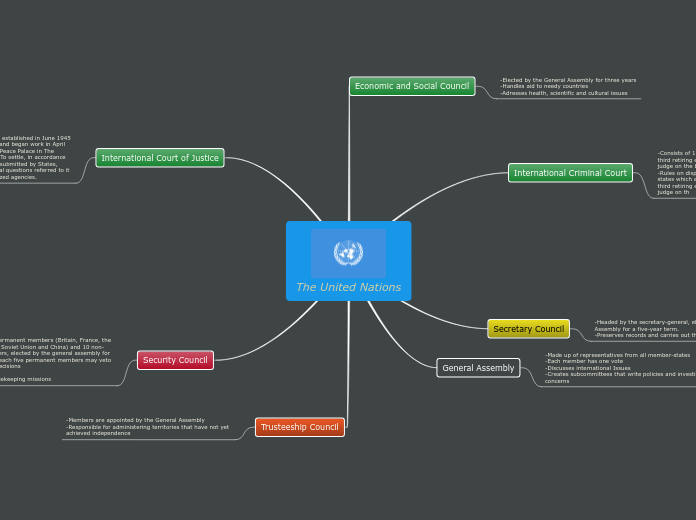The United Nations
Economic and Social Council
-Elected by the General Assembly for three years
-Handles aid to needy countries
-Adresses health, scientific and cultural issues
International Criminal Court
-Consists of 15 judges elected for a nine-year terms, with one-
third retiring every year; no country can have more than one judge on the bench at one time.
-Rules on disputes are voluntarily submitted by members-states which are not-bound to accept ruling.
third retiring every year; no country can have more than one judge on th
Secretary Council
-Headed by the secretary-general, elected by the general
Assembly for a five-year term.
-Preserves records and carries out the orders of it's executive
General Assembly
-Made up of representatives from all member-states
-Each member has one vote
-Discusses international Issues
-Creates subcommittees that write policies and investigate
concerns
International Court of Justice
The International court of justice was established in June 1945 by the Charter of the United Nations and began work in April 1946. The seat of the Court is at the Peace Palace in The Hague. The Court has two functions: To settle, in accordance with international law, legal disputes submitted by States, and. To give advisory opinions on legal questions referred to it by authorized UN organs and specialized agencies.
Security Council
-Consists of five permanent members (Britain, France, the
United States, the Soviet Union and China) and 10 non-
permanent members, elected by the general assembly for
two-years terms; each five permanent members may veto
Security Council decisions
-Orders sanctions
-Creates new peacekeeping missions
Trusteeship Council
-Members are appointed by the General Assembly
-Responsible for administering territories that have not yet
achieved independence
